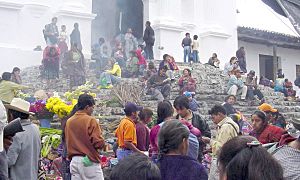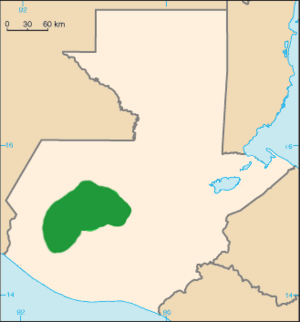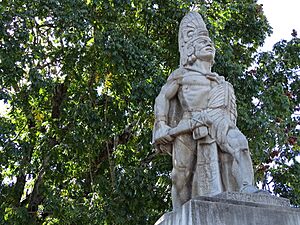Kʼicheʼ people facts for kids
| Total population | |
|---|---|
| 1,680,551 (11.28% of Guatemalan population) |
|
| Regions with significant populations | |
| 1,680,551 | |
| Quiché | 570,985 |
| Totonicapán | 405,765 |
| Quetzaltenango | 227,663 |
| Sololá | 180,488 |
| Suchitepéquez | 143,396 |
| Languages | |
| Kʼicheʼ, Spanish | |
| Religion | |
| Roman Catholic, Evangelical, Maya religion | |
| Related ethnic groups | |
| Kaqchikel, Tzutujil, Uspantek, Sakapultek | |
The Kʼicheʼ (pronounced kee-CHAY) are one of the largest groups of Maya peoples living in Guatemala. They are an indigenous people with a rich history. Their language, also called Kʼicheʼ, is part of the larger Mayan language family.
The word Kʼicheʼ means "many trees." This is where the name Guatemala comes from, as it's a translation of the Kʼicheʼ word. The Quiché Department in Guatemala is also named after them. One famous Kʼicheʼ person is Rigoberta Menchú Tum, who won the Nobel Peace Prize in 1992 for her work defending indigenous rights.
Contents
Who are the Kʼicheʼ People?

About 11% of the people in Guatemala are Kʼicheʼ. This means over 1.6 million Kʼicheʼ people live there. Most of them live in the high mountain areas of Guatemala.
The Quiché Department is like the heartland for the Kʼicheʼ people. Many Kʼicheʼ also live in the departments of Totonicapán, Quetzaltenango, and Sololá.
Most Kʼicheʼ people speak their native Kʼicheʼ language. They also usually know some Spanish. In some very remote villages, people might only speak Kʼicheʼ. Other languages closely related to Kʼicheʼ include Uspantek, Sakapultek, Kaqchikel, and Tzutujil.
Exploring Kʼicheʼ History
The history of the Kʼicheʼ people can be divided into two main parts: before the Spanish arrived and after. The Spanish conquest happened in 1524 when Pedro de Alvarado led his army against them.
The Kʼicheʼ Before the Spanish Conquest
Before the Spanish arrived, the Kʼicheʼ had a very strong kingdom called Qʼumarkaj. This kingdom was one of the most powerful states in the region after the main Maya Civilization declined around 950 AD. The Kʼicheʼ kingdom was located in the highlands of present-day Guatemala.
The main city of the Kʼicheʼ was Qʼumarkaj. It was the center for their government, religious ceremonies, and social life. The city was quite large, covering about 3.25 square kilometers. There was also a lot of cultural sharing between the Kʼicheʼ and people from Central Mexico. For example, the Nahuatl language influenced the Kʼicheʼ language.
The Spanish Conquest and Its Impact
The Kʼicheʼ were conquered by the Spanish leader Pedro de Alvarado in 1524. Their last military commander, Tecun Uman, led the Kʼicheʼ armies against Alvarado and his allies, the Kaqchikel. A big battle took place in the valley of Xelajú (now Quetzaltenango). The Kʼicheʼ armies were defeated, and many Kʼicheʼ people died, including Tecún Umán. Tecún Umán is now a very important hero in Kʼicheʼ stories.
After the battle, the Kʼicheʼ surrendered and invited Alvarado to their capital, Qʼumarkaj. However, Alvarado thought it might be a trap, so he burned the city instead. You can still see the ruins of Qʼumarkaj today, near Santa Cruz del Quiché.
One of the main goals of the Spanish priests during the conquest was to convert the Maya people to Catholicism. They didn't fully convert everyone, but they did change the language. The Kʼicheʼ were among the first groups studied by the Dominican missionaries. These missionaries created a Christian religious text called Theologia Indorum in the Kʼicheʼ language. They tried to change the meaning of some Kʼicheʼ words to fit Catholic ideas. They also made the text sound similar to the Popol Vuh to make it more familiar.
The Kʼicheʼ in the 20th Century
In the early 1980s, the government of Guatemala, led by Efraín Ríos Montt, started a large campaign to stop rebellions. Many of these rebellions were organized by Maya people. Because the Kʼicheʼ are the largest Maya group in Guatemala, they became a main target of these programs. Many native people called this period the Guatemalan Genocide.
The Guatemalan army used harsh methods, like destroying sacred symbols, burning crops, and forcing Maya men to join Civil Defense Patrols. A report by the Guatemalan Historical Clarification Commission found that 98.4% of the victims in Southern Kʼicheʼ were Maya. The Kʼicheʼ people in Southern Quiché are still affected by these events today.
Important Kʼicheʼ Leaders
Ancient Kʼicheʼ Rulers
Historians believe that powerful Kʼicheʼ leaders came to the Guatemalan highlands around 1225 AD. They started their journey after the collapse of the Maya city of Chichén Itzá around 1200 AD. These leaders were in small, mobile groups, mostly men. They soon mixed with the local Kʼicheʼ people. We can list their rulers by estimating how long each generation ruled.
| Dates (AD) | Name |
|---|---|
| 1225–1250 | Bʼalam Kitze |
| 1250–1275 | Kʼokʼoja |
| 1275–1300 | E Tzʼikim |
| 1300–1325 | Ajkan |
| 1325–1350 | Kʼokaibʼ |
| 1350–1375 | Kʼonache |
| 1375–1400 | Kʼotuja |
| 1400–1425 | Quqʼkumatz |
| 1425–1475 | Kʼiqʼabʼ |
| 1475–1500 | Vahxakʼ iKaam |
| 1500–1524 | Oxib Kej |
Tecun Uman: A National Hero
Tecun Uman was the last Kʼicheʼ ruler before the Spanish conquest. He was declared Guatemala's national hero in 1960. His death on February 20, 1524, is remembered every year in Guatemala. This is often done through the Dance of the Conquest, which tells the story of the native people's conversion to Christianity after the Spanish Conquest.
Some Kʼicheʼ writings, like the Título Xucul, say he was very wealthy. They describe him wearing rare quetzal feathers, precious gems, and lots of jewelry. Some historians wonder if Tecun Uman was a real person or more of a legendary figure. This is because Kʼicheʼ stories describe him flying like a quetzal or an eagle. Other scholars believe he was a real person whose story became more grand over time.
Rigoberta Menchú Tum: A Voice for Indigenous Rights
Rigoberta Menchú Tum is a very important Kʼicheʼ woman. In 1996, she became a UN Ambassador for the world’s indigenous peoples. She helped promote the first International Decade of the World's Indigenous People, which focused on the rights of native communities.
She has also run for President of Guatemala twice, in 2007 and 2011, as a member of the Winaq party. Even though she didn't win, she continues to be a strong voice for indigenous rights and culture.
Kʼicheʼ Literature: The Popol Vuh
What is the Popol Vuh?
One of the most important ancient books from Mesoamerica is the Popol Vuh. It was written by the Kʼicheʼ people in the 1550s. The book is a collection of myths and historical stories that the Kʼicheʼ knew at that time. These stories came from older sources that are now lost, and from oral traditions passed down through generations.
The Popol Vuh tells the Kʼicheʼ creation myth, explaining how the world and humans were created by the gods. It also includes the story of divine brothers and the history of the Kʼicheʼ people. It covers their journey to their homeland and continues up to the Spanish conquest.
Why is the Popol Vuh Important Today?
Since it was created, the Popol Vuh has become a very important symbol of indigenous culture. It is important for both modern-day Guatemalans and people of Maya descent. This sacred text is used in religious ceremonies, for university studies, in political movements, and for historical research into the lives of the Maya, especially the Kʼicheʼ. In 1971, it was even declared the official book of Guatemala.
Today, Maya people in Guatemala use the Popol Vuh to help defend their traditional lands and political rights. They use it to preserve their indigenous culture. The Popol Vuh is still studied and analyzed to better understand the spiritual beliefs and practices of the Maya and how they have shaped cultures today.
Images for kids
-
Market day in the Kʼicheʼ town of Chichicastenango
Error: no page names specified (help). In Spanish: Quiché (etnia) para niños





